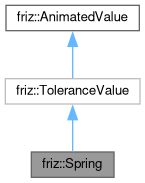Accelerates toward the end value – if this acceleration takes it past the end value, it enters a mode where it acts like a simplified oscillating spring; the behavior of the oscillation can be loosened or tightened using the dampen parameter.
More...
#include <spring.h>
|
| | Spring (float startVal, float endVal, float tolerance, float accel, float dampen) |
| |
|
| ToleranceValue (float startVal, float endVal, float tolerance) |
| |
| float | getNextValue (int, int msSinceLastUpdate) override |
| | Calculate the next value in the sequence based on the delta time since last updated. Internally, we use an update rate of 1 kHz to recalculate values so that we can remain consistent as the actual animation frame rate changes.
|
| |
| bool | isFinished () override |
| | Test to see if this value has reached its end state.
|
| |
| | AnimatedValue (float startVal_, float endVal_) |
| | Base class init for the animated value classes.
|
| |
| virtual float | getNextValue (int msElapsed, int msSinceLastUpdate)=0 |
| |
| float | getEndValue () const |
| | get the ending state of this value object. When we cancel an in-progress animation, we may need to snap to the end value, and this gives a way to get there immediately.
|
| |
| virtual bool | isFinished ()=0 |
| |
| virtual bool | updateTarget (float) |
| | Attempt to change the end value of an animation that's currently in process.
|
| |
| void | cancel (bool moveToEndPosition) |
| | Cancel an in-progress animation.
|
| |
|
|
float | startAcceleration |
| | The initial acceleration for this value.
|
| |
|
float | acceleration |
| | When we're in a damping state, the acceleration will change.
|
| |
|
float | damping |
| | damping factor to apply when we need to oscillate toward end val.
|
| |
|
float | velocity |
| | current velocity, updated with acceleration every frame.
|
| |
|
|
float | tolerance |
| |
|
float | startVal |
| |
|
float | endVal |
| |
|
float | currentVal |
| |
|
bool | canceled { false } |
| |
|
bool | finished { false } |
| |
Accelerates toward the end value – if this acceleration takes it past the end value, it enters a mode where it acts like a simplified oscillating spring; the behavior of the oscillation can be loosened or tightened using the dampen parameter.
◆ Spring()
| friz::Spring::Spring |
( |
float |
startVal, |
|
|
float |
endVal, |
|
|
float |
tolerance, |
|
|
float |
accel, |
|
|
float |
dampen |
|
) |
| |
A curve that accelerates toward the end value, then oscillates toward it on overshoot.
- Parameters
-
| startVal | initial value |
| endVal | end value. |
| tolerance | How close do we need to be to stop animating? |
| accel | Velocity change on each update. |
| dampen | How much to dampen the oscillation, 0 < dampen < 1. smaller values dampen the oscillation faster. |
◆ generateNextValue()
| float friz::Spring::generateNextValue |
( |
| ) |
|
|
overrideprivatevirtual |
The documentation for this class was generated from the following files:
- Source/friz/curves/spring.h
- Source/friz/curves/spring.cpp



 Public Member Functions inherited from friz::ToleranceValue
Public Member Functions inherited from friz::ToleranceValue Public Member Functions inherited from friz::AnimatedValue
Public Member Functions inherited from friz::AnimatedValue Protected Attributes inherited from friz::ToleranceValue
Protected Attributes inherited from friz::ToleranceValue Protected Attributes inherited from friz::AnimatedValue
Protected Attributes inherited from friz::AnimatedValue